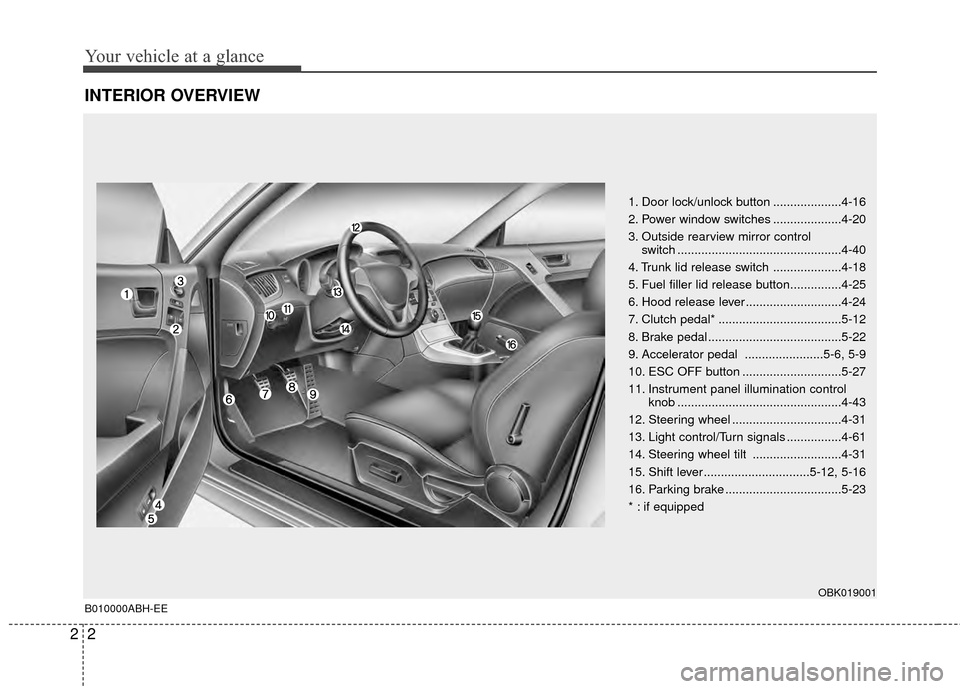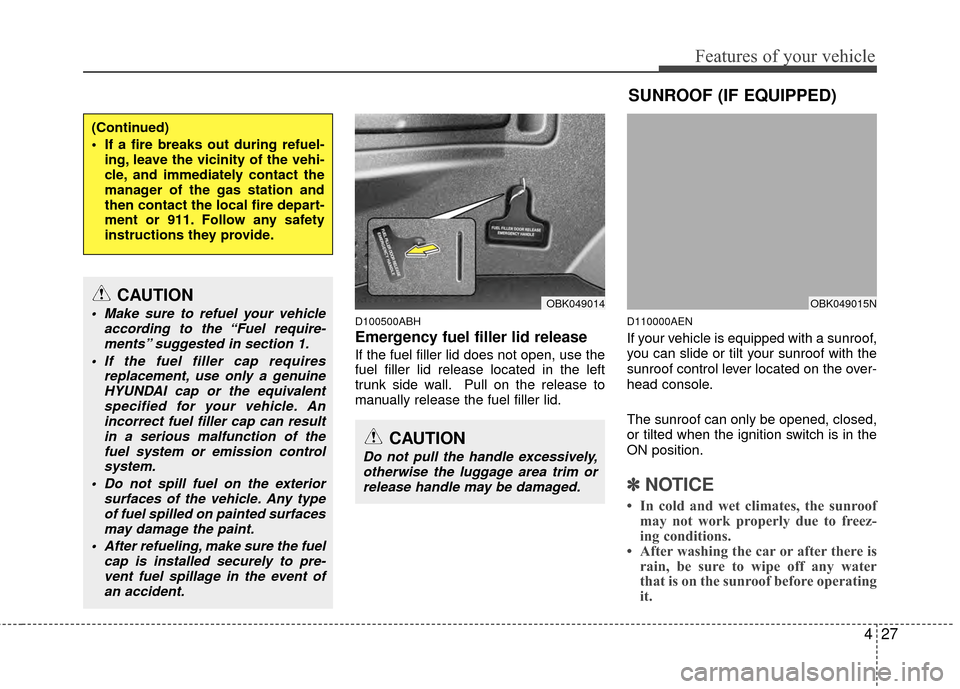2012 Hyundai Genesis Coupe trunk release
[x] Cancel search: trunk releasePage 16 of 391

Your vehicle at a glance
22
INTERIOR OVERVIEW
1. Door lock/unlock button ....................4-16
2. Power window switches ....................4-20
3. Outside rearview mirror control switch ................................................4-40
4. Trunk lid release switch ....................4-18
5. Fuel filler lid release button...............4-25
6. Hood release lever ............................4-24
7. Clutch pedal* ....................................5-12
8. Brake pedal .......................................5-22
9. Accelerator pedal .......................5-6, 5-9
10. ESC OFF button .............................5-27
11. Instrument panel illumination control knob ................................................4-43
12. Steering wheel ................................4-31
13. Light control/Turn signals ................4-61
14. Steering wheel tilt ..........................4-31
15. Shift lever ...............................5-12, 5-16
16. Parking brake ..................................5-23
* : if equipped
OBK019001
B010000ABH-EE
Page 95 of 391

Features of your vehicle
18
4
D050400ABK-EU
Speed sensing door lock system
(if equipped)
Type A
All doors will be automatically locked
when the vehicle speed exceeds 24 mph.
Type B
All doors will be automatically locked
when the vehicle speed exceeds 9 mph.
And all doors will be automatically
unlocked after you turn the engine off or
when you remove the ignition key. (if
equipped)
✽ ✽
NOTICE
An authorized HYUNDAI dealer can
change the speed of the speed sensing
door lock system from approximately 12
mph to approximately 25 mph or dis-
able the system.
D070100ABK-EE
Opening the trunk
To open the trunk, press the trunk
unlock button on the transmitter for
more than 1 second (or smart key).
To open the trunk from inside the vehi- cle, pull the trunk lid release lever.
If the trunk is unlocked, it can be opened by pulling the trunk lid up.
Once the trunk is opened and then closed, the trunk is locked automatical-
ly.
✽ ✽ NOTICE
In cold and wet climates, door locks and
door mechanisms may not work proper-
ly due to freezing conditions.
OBK049007
TRUNK
WARNING- Unlocked
vehicles
Leaving your vehicle unlocked can
invite theft or possible harm to you
or others from someone hiding in
your vehicle while you are gone.
Always remove the ignition key,
engage the parking brake, close all
windows and lock all doors when
leaving your vehicle unattended.
WARNING- Unattended
children
An enclosed vehicle can become
extremely hot, causing death or
severe injury to unattended chil-
dren or animals who cannot escape
the vehicle. Furthermore, children
might operate features of the vehi-
cle that could injure them, or they
could encounter other harm, possi-
bly from someone gaining entry to
the vehicle. Never leave children or
animals unattended in your vehicle.
Page 96 of 391

419
Features of your vehicle
D070200ABH
Closing the trunk
To close the trunk, lower and push down
the trunk lid, until it locks. To be sure the
trunk lid is securely fastened, always
check by trying to pull it up.
D070300ABH
Emergency trunk safety release
Your vehicle is equipped with an emer-
gency trunk release cable located inside
the trunk. The lever glows in the dark
when the trunk lid is closed. If someone
is inadvertently locked in the trunk,
pulling this handle will release the trunk
latch mechanism and open the trunk.
CAUTION
Make certain that you close thetrunk before driving your vehicle. Possible damage may occur to thetrunk lift cylinders and attachedhardware if the trunk is not closedprior to driving.
WARNING
Make sure no objects or people are
near the rear of the vehicle when
opening the trunk.
OBK049008
WARNING
The trunk lid should be always kept
completely closed while the vehicle
is in motion. If it is left open or ajar,
poisonous exhaust gases may
enter the car and serious illness or
death may result.
WARNING
No one should be allowed to occupy the trunk of the vehicle at
any time. If the trunk is partially
or totally latched and the person
is unable to get out, severe injury
or death could occur due to lack
of ventilation, exhaust fumes and
rapid heat build-up, or because of
exposure to cold weather condi-
tions. The trunk is also a highly
dangerous location in the event
of a crash because it is not a pro-
tected occupant space but is a
part of the vehicle’s crush zone.
Your vehicle should be kept locked and keys be kept out of
the reach of children. Parents
should teach their children about
the dangers of playing in trunks.
Page 104 of 391

427
Features of your vehicle
D100500ABH
Emergency fuel filler lid release
If the fuel filler lid does not open, use the
fuel filler lid release located in the left
trunk side wall. Pull on the release to
manually release the fuel filler lid.
D110000AEN
If your vehicle is equipped with a sunroof,
you can slide or tilt your sunroof with the
sunroof control lever located on the over-
head console.
The sunroof can only be opened, closed,
or tilted when the ignition switch is in the
ON position.
✽ ✽NOTICE
• In cold and wet climates, the sunroof
may not work properly due to freez-
ing conditions.
• After washing the car or after there is rain, be sure to wipe off any water
that is on the sunroof before operating
it.
(Continued)
If a fire breaks out during refuel-
ing, leave the vicinity of the vehi-
cle, and immediately contact the
manager of the gas station and
then contact the local fire depart-
ment or 911. Follow any safety
instructions they provide.
CAUTION
Make sure to refuel your vehicle according to the “Fuel require-ments” suggested in section 1.
If the fuel filler cap requires replacement, use only a genuineHYUNDAI cap or the equivalentspecified for your vehicle. Anincorrect fuel filler cap can resultin a serious malfunction of the fuel system or emission controlsystem.
Do not spill fuel on the exterior surfaces of the vehicle. Any typeof fuel spilled on painted surfacesmay damage the paint.
After refueling, make sure the fuel cap is installed securely to pre-vent fuel spillage in the event ofan accident.
CAUTION
Do not pull the handle excessively,otherwise the luggage area trim orrelease handle may be damaged.
SUNROOF (IF EQUIPPED)
OBK049015NOBK049014
Page 300 of 391

621
What to do in an emergency
When towing your vehicle in an emer-
gency without wheel dollies :
1. Set the ignition switch in the ACC posi-tion.
2. Place the shift lever in N (Neutral).
3. Release the parking brake.
F080200ABK
Removable towing hook
(if equipped)
1. Open the trunk, and remove the tow- ing hook from the tool case.
2. Remove the hole cover pressing the lower part of the cover on the front or
rear bumper. 3. Install the towing hook by turning it
clockwise into the hole until it is fully
secured.
4. Remove the towing hook and install the cover after use.
CAUTION
Failure to place the shift lever in N(Neutral) may cause internal dam-age to the transmission.
OBK069010
OBK069011
Front
Rear
Page 385 of 391

Index
4I
Door locks··················\
··················\
··················\
················4-15Central door lock switch ··················\
··················\
·······4-17
Driver's air bag··············\
··················\
··················\
·············3-44
Driving at night··················\
··················\
··················\
········5-39
Driving in flooded areas ··················\
··················\
············5-40
Driving in the rain ··················\
··················\
··················\
···5-40
Economical operation ··················\
··················\
················5-56
Electric chromic mirror (ECM) ··················\
··················\
·4-33
Electronic stability control (ESC) ··················\
···············5-27
Emergency starting ··················\
··················\
··················\
····6-4 Jump starting ··················\
··················\
··················\
·········6-4
Push starting ··················\
··················\
··················\
··········6-5
Emergency trunk safety release ··················\
··················\
·4-19
Emergency towing ··················\
··················\
··················\
···6-22
Emergency while driving··················\
··················\
·············6-2
Emission control system ··················\
··················\
············7-67 Crankcase emission control system ··················\
········7-67
Evaporative emission control (including ORVR) System ··················\
··················\
··················\
··············7-67
Exhaust emission control system ··················\
············7-68
Engine compartment ··················\
··················\
············2-4, 7-2
Engine coolant ··················\
··················\
··················\
·········7-17
Engine number ··················\
··················\
··················\
···········8-7
Engine oil ··················\
··················\
··················\
·················7-16\
Engine overheats··················\
··················\
··················\
········6-6 Engine start/stop button ··················\
··················\
···············5-7
Engine temperature gauge ··················\
··················\
·········4-44
Engine will not start··················\
··················\
··················\
···6-3
Evaporative emission control (including ORVR)
System ··················\
··················\
··················\
·················7-67\
Exhaust emission control system··················\
·················7-68\
Explanation of scheduled maintenance items ···············7-13
Exterior care··················\
··················\
··················\
·············7-61
Flat tire ··················\
··················\
··················\
··················\
···6-12 Changing tires ··················\
··················\
··················\
·····6-13
Compact spare tire ··················\
··················\
················6-18
Jack and tools ··················\
··················\
··················\
······6-12
Removing and storing the spare tire ··················\
·······6-13
Floor mat anchor(s) ··················\
··················\
··················\
·4-97
Fluid Brake/clutch fluid ··················\
··················\
··················\
7-20
Power steering fluid ··················\
··················\
··············7-21
Washer fluid ··················\
··················\
··················\
········7-22
Folding the rear seat ··················\
··················\
··················\
3-11
Front fog light bulb replacement ··················\
·················7-56\
Front seat adjustment - manual ··················\
··················\
···3-4
Front seat adjustment - power ··················\
··················\
·····3-9
Fuel filler door ··················\
··················\
··················\
·········4-25
Fuel gauge··················\
··················\
··················\
················4-45
Fuel requirements ··················\
··················\
··················\
······1-3
E
F
Page 390 of 391

I9
Index
Recommended cold tire inflation pressures ··············7-33
Snow tires ··················\
··················\
··················\
············7-45
Summer tires ··················\
··················\
··················\
·······7-45
Tire care··················\
··················\
··················\
···············7-33
Tire chains ··················\
··················\
··················\
···········7-45
Tire maintenance ··················\
··················\
··················\
·7-39
Tire replacement ··················\
··················\
··················\
··7-37
Tire rotation ··················\
··················\
··················\
·········7-35
Tire sidewall labeling ··················\
··················\
············7-39
Tire terminology and definitions··················\
·············7-43
Tire traction ··················\
··················\
··················\
·········7-39
Wheel alignment and tire balance ··················\
···········7-36
Wheel replacement ··················\
··················\
················7-38
Tires pressure monitoring system (TPMS)··················\
····6-7 Changing a tire with TPMS ··················\
··················\
··6-10
Low tire pressure indicator ··················\
··················\
·····6-8
TPMS (Tire pressure monitoring system) malfunction indicator ··················\
··················\
··········6-9
Towing ··················\
··················\
··················\
··················\
···6-20 Emergency towing··················\
··················\
·················6-22\
Towing capacity ··················\
··················\
··················\
·······5-47
Trailer towing ··················\
··················\
··················\
··········5-52
Transaxle Automatic transaxle ··················\
··················\
··············5-16
Manual transaxle ··················\
··················\
··················\
·5-12
Trip computer ··················\
··················\
··················\
··········4-46
Tripmeter··················\
··················\
··················\
··················\
4-47 Trunk ··················\
··················\
··················\
··················\
······4-18
Emergency trunk safety release ··················\
··············4-19
Turn signal light bulb replacement ··················\
··············7-56
Vehicle break-in process ··················\
··················\
··············1-5
Vehicle certification label ··················\
··················\
············8-6
Vehicle data collection and event data recorders ············1-6
Vehicle identification number (VIN) ··················\
·············8-6
Vehicle load limit ··················\
··················\
··················\
·····5-46 Cargo capacity ··················\
··················\
··················\
·····5-47
Certification label ··················\
··················\
··················\
5-49
Seating capacity ··················\
··················\
··················\
··5-46
Tire and loading information label··················\
··········5-46
Towing capacity ··················\
··················\
··················\
··5-47
Vehicle capacity weight ··················\
··················\
········5-46
Vehicle weight glossary ··················\
··················\
·············5-51 Base curb weight ··················\
··················\
··················\
·5-51
Cargo weight ··················\
··················\
··················\
·······5-51
GAW (Gross axle weight) ··················\
··················\
·····5-51
GAWR (Gross axle weight rating)··················\
··········5-51
GVW (Gross vehicle weight)··················\
··················\
5-51
GVWR (Gross vehicle weight rating) ··················\
····5-51
Vehicle curb weight··················\
··················\
···············5-51
V